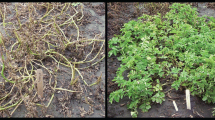Summary
The world is changing, and the rate of change is accelerating, nowhere moreso than in the pace of scientific discovery and the advance of technology. The last thirty years have also seen substantial global changes in potato production which are likely to continue if current projections are correct. Climate change is bound to affect local weather patterns, which will influence both the epidemiology of pests and pathogens and broaden their geographic range. An agenda for future research will of necessity include much of the current agenda; research into more sustainable systems; research into new and novel resistances to biotic and abiotic constraints, combining modern cell and molecular-based technologies with classical breeding approaches and research into the genetic and biochemical bases of low temperature sweetening and dormancy control, that should lead to varieties with superior storage characteristics, particularly for processing. However, a future agenda has to retain some flexibility and a component of speculative research. Perhaps potatoes could become a source of industrial feedstock or pharmaceuticals, perhaps there is a place for cultivars produced by botanic seed in Europe? The exciting thing about research is that we cannot always predict where it will lead, and a future agenda must not curb the enthusiasm of any young scientist by too rigidly adhering to that suggested here. it is essential that scientific options are kept open.
Similar content being viewed by others
References
Anonymous, 1971. The Compact Edition of the Oxford English Dictionary. Oxford University Press.
Anonymous, 1995. Potatoes in the 1990s: Situation and prospects for the world. CIP/FAO, Rome.
Batchelor, S.E., E.J. Booth, G. Entwistle, K.C. Walker, L. Morrison, G.R. Mackay, T. apRees & A. Hacking, 1996. Industrial markets for UK-grown starch.Outlook on Agriculture 25 No. 1: 43–48.
Bradshaw, J.E. M.F.B. Dale, G.R. Mackay, M.S. Phillips, H.E. Stewart & R.L. Wastie, 1994. Potato breeding viewed as multitrait genotypic recurrent selection.Potato Research 37: 334.
Bradshaw, J.E. & G.R. Mackay, 1994. Breeding strategies for clonally propagated potatoes. In: J.E. Bradshaw & G.R. Mackay (Eds), Potato Genetics. CAB International, Wallingford, UK, pp. 467–497.
Carnegie, S.F., G.A. Hide, A.M. Cameron, P. Haddon & S.M. Hall, 1996. Tuber health of Scottish seed potatoes. In: Abstracts of conference papers, posters and demonstrations of the 13th EAPR Triennial Conference, Veldhoven, The Netherlands, pp. 109–110.
Cisneros, F. & P. Gregory, 1994. Potato pest management.Aspects of Applied Biology 39.
Culter, E.G., 1992. Structure and development of the potato plant. In: P.M. Harris (Ed.), The Potato Crop. The scientific basis for improvement. Chapman & Hall, London, pp. 65–161.
Davies, H.V. & G.R. Mackay, 1994. Exploitation of genetic variation to improve potato quality.Aspects of Applied Biology 39: 45–49.
Elphinstone, J.G., 1996. Survival and possibilities for extinction ofPseudomonas solanacearum in cool climates. In: Abstracts of conference papers, posters and demonstrations of the 13th EAPR Triennial Conference, Veldhoven, The Netherlands, pp. 14–15.
French, E., 1994. Integrated control of bacterial wilt in potatoes.CIP Circular Vol. 20, No. 2, pp. 8–11.
Fry, W.E. & S.B. Goodwin, 1995. Recent migrations ofPhytophthora infestans. In: L.J. Dowley, E. Bannon, L. Cooke, T. Keane & E. O. Sullivan (Eds),Phytophthora infestans 150. Boole Press, Dublin, pp. 89–95.
Hermsen, J.G.Th., E. Jongedijk & M.S. Ramanna, 1987. An evaluation of new methods and techniques for potato breeding. In: Proceedings of the 10th EAPR Triennial Conference, Aalborg, Denmark, pp. 30–41.
Jacobsen, E., J.H.M. Hovenkamp-Hermelink, H.T. Krijgsheld, H. Nijdam, L.P. Pijnacker, B. Witholt & W.A. Feenstra, 1989. Phenotypic and genotypic characterization of an amylosefree starch mutant of potato.Euphytica 44: 43–48.
Jones, D.A., C.M. Thomas, K.E. Hammond-Kosack, P.J. Balint-Kurti & J.D.G. Jones, 1994. Isolation of the tomato Cf-9 gene for resistance toCladosporium fulrum by transposon tagging.Science 266: 789–793.
Law, C.N., 1995. Genetic manipulation in plant breeding-prospects and limitations.Euphytica 85:1–12.
Loon, C.D. van, P. Bedin & W. Reust, 1993. Vers une production de pomme de terre respecteuse de l'environment. In: Proceedings of the 12th EAPR Triennial Conference, Paris, France, pp. 36–56.
Machray, G.C., L. Burch, P.E. Hedley, H.V. Davies & R. Waugh, 1994. Genes of sucrose metabolism in potato and manipulation of their expression. Proceedings of the International Colloquium: Impact of Plant Biotechnology on Agriculture. Planprint, Ljubljana, pp. 201–210.
Mackay, G.R. & M.F.B. Dale, 1991. Quality in potatoes. Scottish Crop Research Institute, Annual Report 1990, pp. 9–12.
McRae, D.C., 1978. Potato harvesting and transport: A survey of the present state of development of potato harvesting with special reference to Scotland. In: Survey Papers of the 7th EAPR Triennial Conference, Warsaw, Poland, pp. 79–96.
Ross, H., 1986. Potato breeding-problems and perspectives. Verlag Paul Parey, Berlin and Hamburg.
Scott, G.J., 1996. Paradoxes and projections for potatoes in the 1990s. Entwicklung ländicher Raum. 30 Jahrgang Heft 3/96, pp. 20–22.
Secor, G.A., N.C. Gudmestad, D.A. Preston & J. Rodriguez, 1995. Late blight management in a traditionally blight-free area. In: L.J. Dowley, E. Bannon, L.R. Cooke, T. Keane & E. O. Sullivan (Eds),Phytophthora infestans 150. Boole Press, Dublin, pp. 333–338.
Spiertz, J.H.J. & G.J.H. de Vries, 1996. Environmentally safe and consumer-friendly potato production. In: Abstracts of conference papers, posters and demonstrations of the 13th EAPR Triennial Conference, Veldhoven, The Netherlands, pp. 3–5.
Wastie, R.L., P. Rousselle & R. Waugh, 1993. A review of techniques for acquiring pest and disease resistance. In: Proceedings of the 12th EAPR Triennial Conference, Paris, France, pp. 57–74.
Zaag, D.E. van der, 1990. The implications of micropropagation for the future use of seed production systems in Europe. In: Abstracts of conference papers and posters of the 11th EAPR Triennial Conference, Edinburgh, Scotland, pp. 28–45.
Zaag, D.E. van der & W.G. Burton, 1978. Potential yield of the potato crop and its limitations (suggestions for research to improve acual yield). In: Survey Papers of the 7th EAPR Triennial Conference, Warsaw, Poland, pp. 7–22.
Author information
Authors and Affiliations
Rights and permissions
About this article
Cite this article
Mackay, G.R. An agenda for future potato research. Potato Res 39, 387–394 (1996). https://doi.org/10.1007/BF02357944
Issue Date:
DOI: https://doi.org/10.1007/BF02357944




